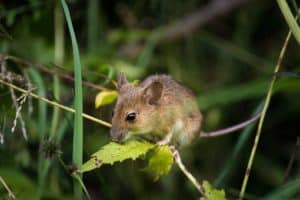How to Prevent Ticks from Biting You
How Do You Prevent Tick Bites?
Ticks seem to be everywhere these days and this makes it difficult to enjoy outdoor activities without worrying about getting bitten and possibly contracting Lyme disease or other potentially serious infections.
The following information addresses:
- How to Use Insect Repellents* to keep ticks off of you.
- Other practices that can help avoid getting bitten by ticks.
- And some basic information about ticks and their habitat which will help you understand how they live and feed (which can help in your effort to reduce the likelihood of getting bitten).
* Check with a doctor before using any insect repellent on a child. Never use these products at all on babies younger than 3 months old. Check with your veterinarian to find out what produces are safe for you pets. Follow all product label instructions.
Step 1: Know Thine Enemy!
The first line of defense is to know a little about ticks. Follow the information below, and you will be better prepared to avoid getting bitten by ticks.
Click here to learn How to Remove a Tick.
How Do Ticks Find You?
By simply breathing, ticks can find you. By exhaling, ticks know your location and that you are a potential “host” (source of a blood-meal). If somehow you manage to avoid breathing (not recommended), ticks can still detect hosts by odors and heat from an animal’s body. If that isn’t enough, they can also sense vibrations and moisture. All of these traits make it all but impossible to avoid these nasty parasites.
How Do Ticks Get On You?
Ticks start their life on the ground, in the egg-stage. As ticks mature, and need to feed, they will find a well-traveled path and get into position to latch onto a host. Ticks climb up stalks of tall grass  or onto the tips of leaves of other low-lying plants. They will only go as high as 2-3 feet off the ground at most. This position is called “questing”.
or onto the tips of leaves of other low-lying plants. They will only go as high as 2-3 feet off the ground at most. This position is called “questing”.
From the questing position, they will latch onto mammals such as people, dogs, cats, mice, deer and horses. When a host brushes up against the vegetation, the tick will climb on board. When ticks climb on a host and find bare skin, they will sometimes latch on (bite) right away, other times they will crawl around (usually up) looking for soft skin. After feeding, a tick drops to the ground and starts the process of finding a new host all over again.
How to Keep Ticks Off of You.
It is helpful to keep in mind that ticks start low on your body and crawl up. They cannot fly or jump and they do not drop out of tree branches onto your head. When ticks are found on a person’s head, they have crawled there, they do not ‘land’ there.
 With this in mind, a strategic approach to tick-avoidance can be implemented.
With this in mind, a strategic approach to tick-avoidance can be implemented.
- Treat your clothing with insect repellent – spraying your shoes, socks and pant legs is a good tick-prevention method.
- Apply an insect repellent to all exposed skin.
- Tuck In Your Clothes – Tucking your shirt into your pants and then your pants into your socks will make it difficult for ticks to get to your skin. Light colored clothing makes it easier to see ticks.
- Insect Repellent Clothing – Insect repellent clothing can also be purchased. This clothing has been treated with the insecticide permethrin and is advertised to remain effective even after being washed dozens of times.
| Permethrin-Treated Clothing is a Very Good Secondary Line of Defense – but it should NOT be the Primary Insect Repellent used for ticks. |
You can also treat your own clothing with permethrin. When treating your clothes with permethrin, the insecticide will need to be re-applied after being washed 2-3 times or after 2-3 weeks, whichever comes first.
Insect repellents can damage some clothing fabrics. If this is a concern, be sure to read the label and test the repellent on a small area of the hem or another inconspicuous area.
Note: You can see that permethrin is not in our list of the most effective insect repellents. Permethrin is a synthetic insecticide that mimics the natural insecticide of the chrysanthemum flower. It does not technically repel insects. It works more like an insecticide and kills the insect.
Insects are still likely to land on someone using permethrin-treated clothing and the idea is that the insect will die or become unable to function before it bites you. In our opinion, permethrin-treated clothing is a very good additional line of defense but it should not be the primary insect repellent.
Also, do not put permethrin on bare skin. It is not harmful but, skin breaks down permethrin and, after about 15 minutes, it will become completely ineffective. Just use permethrin on clothing, backpacks or other materials – not skin.
Organic Tick Control at Your Home
| Cedar Oil is a Very Good Product of Controlling Ticks & Mosquitoes |
Well maintained turfgrass is not tick friendly because ticks need to climb higher than the height of a properly mowed lawn to latch onto a host. Therefore, keeping your lawn weed free and mowed at an appropriate height is a good way to reduce the habitat that ticks require. Ticks that are found in lawn areas have typically dropped off of an animal crossing the lawn.
Landscape beds often are tick-friendly. Treating landscape beds is important. Green Giant’s tick & mosquito program includes treatments of landscape beds, areas adjacent to meadow grasses, edges of forests and tree lines. It is also a good practice to treat high use areas in a lawn – such as around a swing set, outdoor kitchen, picnic table or swimming pool.
The product that we have found works the best for mosquitos & ticks is Cedar Oil. The treatments need to be made every 3-4 weeks and the results have been very good. Additionally, customers (and our employees) love that it’s organic!
Other ways to Avoid Ticks
Thick Barrier
A “Thick Barrier” is a 3-5 foot wide strip with no vegetation that runs between tick-friendly areas (meadows, tall grasses, woodland areas…) and your lawn. Think of a path made out of cinders or wood chips. Ticks do not like this vegetation-free area and it will keep ticks from crawling from the tick-friendly areas onto your lawn. The idea is that you create a ‘safe zone’ in the portions of your yard where your family spends time.
Control Mice – Ticks get Lyme Disease from Mice
 Ticks get the Lyme disease pathogen from feeding on the blood of mice. Mice are also a major food source for ticks. Therefore controlling the population of mice is important. If you have ever seen a mouse covered in ticks, you know it is really ugly – one mouse can have dozens of ticks latched-on at a time. Getting rid of the mice will reduce the blood-meal options for ticks. Green Giant’s pest control division does a lot of work with weather and child resistant mouse control devices. Request your free estimate!
Ticks get the Lyme disease pathogen from feeding on the blood of mice. Mice are also a major food source for ticks. Therefore controlling the population of mice is important. If you have ever seen a mouse covered in ticks, you know it is really ugly – one mouse can have dozens of ticks latched-on at a time. Getting rid of the mice will reduce the blood-meal options for ticks. Green Giant’s pest control division does a lot of work with weather and child resistant mouse control devices. Request your free estimate!
| Ticks Feed on Mice = Ticks get Lyme Disease from Mice
Exterminating Mice = Reduced Tick Populations |
How to Avoid Ticks While Hiking…
Stay out of tall grass areas.
| Ticks crawling on you can be easily removed with sticky tape. |
Try to avoid narrow trails with tall grasses that you have to brush up against. Stay in the middle of the trail if possible. Check your shoes and legs after going through tall grasses. Crawling ticks  can be easily removed with scotch or masking tape – simply dab the sticky side onto the tick & fold over the tape to encase the tick.
can be easily removed with scotch or masking tape – simply dab the sticky side onto the tick & fold over the tape to encase the tick.
Perform Tick Inspections. The longer a tick is embedded in a person, the higher the likelihood that Lyme disease will be transmitted. So, do the inspections as soon as possible. Run our fingers through your hair. Check your entire body.
Showering after your hike can help wash off ticks.
Long Sleeves and Pants
Polyester and nylon clothing is very light and comfortable these days and can keep ticks (and mosquitoes) off of your body. The clothing also provides protection from the sun. Loose fitting clothing make it harder for mosquitoes to bite through thin clothing. Ticks can bite through thin clothing but, they usually just fall off from the movement of the clothing.
What Time of Year are Ticks the Worst?
| Knowledge is Power Most people are infected by nymphs (immature ticks). Nymphs are tiny – less than 2 mm so they can easily go undetected. |
Timing Determines Risk Level. Spring and summer are the riskiest times of year for tick bites. During these seasons, ticks are in a juvenile stage called “nymphs”. Nymphs are small, making them harder to see, and they carry heavier loads of infectious pathogens at these times of year.
If you are Bitten By a Tick, Remove it As Soon As Possible.
The CDC says that removing a tick that has latched on to you (bitten you) within 24 hours greatly reduces the chance of contracting Lyme disease. Click Here to Learn the Best Ways to Remove a Tick.
If you are suffering from Lyme Disease, or think you may be, reach out to Anne Desjardins.
Anne founded and runs the Berks County Lyme Support Group and can be reached here: BerksLyme@PaLyme.org
For additional information, go to https://palyme.org/
If you need help with tick control, contact Green Giant for a free estimate today!
You may also be interested in these blogs:
What are the Best Insect Repellents?

Lawn Care
Green Giant Home & Commercial’s Lawn Care services control weeds, build the thickness and density of your lawn and protect it from being damaged by insects and disease, providing you with a great-looking, healthy lawn. We offer fertilization, weed control, liming, insect control, and aeration and overseeding. Visit our Lawn Care page for more information.
Tree Care
Green Giant performs: Proper Diagnosis and Treatment of Tree & Shrub Problems, Insect & Disease Control (including Spotted Lanternfly), and Nutrient Management via Deep Root Fertilization to keep your plants healthy and thriving. Visit our Tree Care page for more information.
Vegetation Management
Green Giant’s Non-Lawn Weed Control services eliminate unwanted vegetation in a wide variety of locations for both residential and large commercial/municipal properties. Areas include fence lines, around obstacles to reduce weed eating, stone/gravel driveways & parking lots, swales, roadside/curbside vegetation management and more. Find more information, visit our Vegetation Management page.
Pest Control
Our full service pest control division provides both Year-Round Service Programs that cover the vast majority of pests that you will encounter and also One-Time Corrective Services for pests such as bees, ants, termites or mice. For more information, visit our Pest Control page.